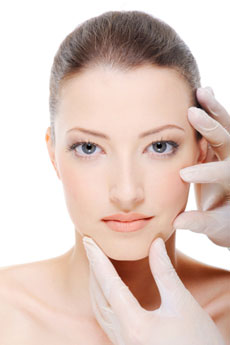 Bvine
collagen was the first filler injected to augment the
face. Over 1.5 million
soft tissue filler procedures were performed in the United
States in 2007; hyaluronic acid (HA) is the most frequently used
agent. In fact, HA has become the most commonly used filler
worldwide. Not all injections are created equal, however, and no
filler is ideal, nor can a single filler meet every patient's wishes
and expectations. Bvine
collagen was the first filler injected to augment the
face. Over 1.5 million
soft tissue filler procedures were performed in the United
States in 2007; hyaluronic acid (HA) is the most frequently used
agent. In fact, HA has become the most commonly used filler
worldwide. Not all injections are created equal, however, and no
filler is ideal, nor can a single filler meet every patient's wishes
and expectations.
Facial fillers can be broadly divided into 4 categories:
- Autologous fat
- Collagens
- Hyaluronic acid-a naturally occurring substance in your skin
that helps to hydrate and add volume, and
- Synthetic fillers
Areas commonly addressed in the face include the forehead, glabella, nasolabial
folds, and lips.
Dermal Fillers are used to:
- smooth the
lines around the mouth and nose
- enhance the size and shape of
lips
- reduce over age smile lines
- enhance and add volume to temple, forehead, nose, cheeks and
lower face
The most appropriate lines to treat with dermal fillers are
those that are visible when your face is still.
One product currently being trialled by the AAD, is
calcium hydroxylapatite, which restores facial volume and promotes collagen
production. The filler, also known as Radiesse, is thicker than the
hyaluronic acid fillers currently available and the results last longer � up
to a year in most cases. It is composed of calcium based microspheres
suspended in a water based gel
|
How dermal fillers works?
 Dermal filler is a nonsurgical treatment. The patient
should be in a relaxed and generally supine position. The filler is
injected under the skin using a fine needle to smooth away lines,
restore natural contours and enhance lips for a smooth, natural and
refreshed appearance. Filler can be injected by one of the
following 4 techniques: serial puncture, threading, fanning, and
crosshatching. Each technique has advantages for certain situations,
and the ultimate determining factor is often surgeon preference. Dermal filler is a nonsurgical treatment. The patient
should be in a relaxed and generally supine position. The filler is
injected under the skin using a fine needle to smooth away lines,
restore natural contours and enhance lips for a smooth, natural and
refreshed appearance. Filler can be injected by one of the
following 4 techniques: serial puncture, threading, fanning, and
crosshatching. Each technique has advantages for certain situations,
and the ultimate determining factor is often surgeon preference.
To begin with the doctor will examine the soft tissue of your face
to assess the depth of
wrinkles and folds and determine your treatment. He might ask to
take pre-treatment photographs so you can see the difference after
treatment! Although anesthesia is not required, some doctors might
suggest use of topical anesthesia to numb the treatment area first.
Following the injection, they may gently massage the treated areas.
The procedure is quick and easy. The injection itself typically
takes 15-30 minutes.
After Care:
For the first 24 hours following treatment,
-
Avoid strenuous exercise, excessive sun or heat exposure,
and Consumption of alcoholic beverages in order to help minimize
the risks of temporary redness, swelling, and/or itching at the
treatment sites.
-
Some temporary injection-related reactions may occur,
including redness, pain, firmness, swelling, and bumps. Studies
have shown that these are usually mild to moderate in nature and
clear up on their own in 7 days or less.
-
If you experience swelling at the injection site, you can
apply an ice pack for a brief period.
-
Make-up application is to be avoided until allowed by the
doctor.
Most patients require only one treatment to achieve optimal
wrinkle smoothing or volume enhancement, and results may last up to
1 year. However, results may vary and correction is temporary.
Risks of Dermal Fillers
Thousands of patients who have received anti-ageing injections
could be at risk of serious complications, senior doctors have
warned, raising fears about the safety of non-surgical cosmetic
procedures.
According to specialist, these "facial fillers" can cause
infections and deformities, if injected into patients by
unqualified practitioners. Also, patients who had fillers up to 10
years ago are now coming forward with complaints of discomfort and
other complications.
Common side effects to facial fillers
include
-
Bruising of the skin
-
Swelling at injection site- A new
study examined the incidence of edema, a
possible side effect of dermal fillers,
after hyaluronic acid injections.
Published in the
American Journal of Cosmetic Surgery,
the study looked at cases of swelling
for injections done to the under eye
area.
-
Lumpiness that is temporary
Besides, if there is a significant amount of
sagging in the skin, the treatments will not produce much in the
way of results.
Note: Anyone with a sensitivity to gram-positive
bacteria proteins should not undergo injection with those hyaluronic
acid products derived from bacterial fermentation. A skin test must
be performed prior to injection of fillers derived from bovine
sources
For More:
|









